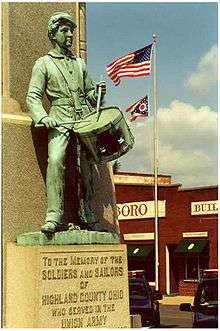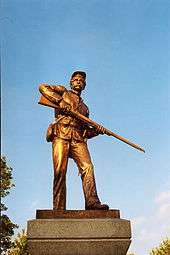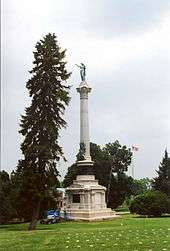Caspar Buberl
| Caspar Buberl | |
|---|---|
 Soldiers and Sailors Memorial, Hillsboro, Ohio | |
| Born |
1834 Kynšperk nad Ohří, Czech Republic |
| Died |
August 22, 1899 New York, New York, United States |
| Nationality | American |
| Known for | Sculpture |
Caspar Buberl (1834 – August 22, 1899) was an American sculptor. He is best known for his Civil War monuments, for the terra cotta relief panels on the Garfield Memorial in Cleveland, Ohio (depicting the various stages of James Garfield's life), and for the 1,200-foot (370 m)-long frieze on the Pension Building in Washington, D.C..
Biography
Born in Königsberg, Bohemia, (now Kynšperk nad Ohří, Czech Republic), as a young man Buberl studied art in Prague and Vienna before immigrating to the United States in 1854 to train under sculptor Robert Eberhard Launitz.[1] In 1882 Montgomery C. Meigs was chosen to design and construct the new Pension Building, now the National Building Museum, in Washington D. C. and, in doing so, broke away from the established Greco-Roman models that had been the basis of government buildings in Washington up until then, and was to continue to be following the Pension Building's completion. Meigs based his design on Italian Renaissance precedents, notably Rome's Palazzo Farnese and Plazzo della Cancelleria.
Included in his design was a 1,200-foot (370 m)-long sculptured frieze executed by Buberl. Since creating a work of sculpture of that size was well out of Meigs' budget, he had Buberl create 28 different scenes [totaling 69 feet (21 m) in length), which were then mixed and slightly modified to create the continuous parade that includes over 1,300 individual figures. Because of the way that the 28 sections were modified and intermixed, it is only by somewhat careful examination that the frieze reveals itself to be the same figures repeated some eighteen times. The sculpture includes infantry, navy, artillery, cavalry and medical components as well as a good deal of the supply and quartermaster functions, since Meigs had overseen the latter two functions during the Civil War.
Meigs insisted that any teamster included in the Quartermaster panel "must be a negro, a plantation slave, freed by war". This figure was ultimately to assume a position in the center, over the west entrance to the building.
Buberl created dozens of Civil War statues and monuments for various cities and states, including several for New York veterans associations to be placed on the Gettysburg Battlefield and a bronze bust of President Abraham Lincoln, which was recently sold for $5,800.[2] His impressive New York State Monument crowns Cemetery Hill, and a number of individual memorials for specific regiments dot the battlefield.
He died in New York City.
Leading works
Monuments on the Gettysburg battlefield


- 9th New York Cavalry Monument – dedicated July 1, 1888
- 4th New York Independent Battery – dedicated July 2, 1888
- 5th New York Cavalry Monument – dedicated July 3, 1888
- 126th New York Infantry – dedicated October 3, 1888
- 10th New York Cavalry Monument – dedicated October 9, 1888
- 54th New York Infantry – dedicated July 4, 1890
- 111th New York Infantry Monument – dedicated June 26, 1891
- New York State Monument – dedicated July 2, 1893
- 41st New York Infantry – dedicated July 3, 1893
- 52nd New York Infantry – dedicated July 3, 1893
Other Civil War monuments
- Civil War Monument, Manchester, New Hampshire, George Keller, architect, 1879

- Soldiers and Sailors Monument, Buffalo, New York, George Keller, architect, 1884
- Soldiers and Sailors Monument, Nashua, New Hampshire, 1889
- Alexandria Confederate Memorial, Alexandria, Virginia, 1889
- Soldiers and Sailors Monument, Troy, New York, 1890.
- Four relief panels: Cavalry, Artillery, Infantry, The Monitor and the Merrimac
- A.P. Hill Monument, Richmond, Virginia, 1892
- Howitzer Monument, Richmond, Virginia, 1892
- Confederate Monument, University of Virginia Cemetery, Charlottesville, Virginia, 1893
- Raphael Semmes Monument, Mobile, Alabama, 1899[3]
Other memorials and monuments
- Fulton Memorial, Fulton Park, Brooklyn, New York, 1872
- Fireman's Memorial, Church Square Park, Hoboken, New Jersey, 1891
- Dewey Triumphal Arch, Spanish–American War, New York City, 1899
Architectural sculpture

- Columbia Defending Science and Industry, National Museum/Art and Industries Building, Washington, D.C., Adolph Cluss, architect, Montgomery Meigs, associate architect, 1881
- Pension Building Frieze, National Building Museum, Washington, D.C., Montgomery Meigs, architect, 1883
- James A. Garfield Memorial, Lake View Cemetery, Cleveland, Ohio, George Keller, architect, 1890
- Soldiers and Sailors Memorial Arch, Hartford, Connecticut, George Keller, architect, 1890
Pension Building frieze
 National Building Museum
National Building Museum Corner figures
Corner figures- South entrance
 Black teamster
Black teamster
Images of the James A. Garfield Memorial

 James A. Garfield Memorial detail – Garfield, the Educator
James A. Garfield Memorial detail – Garfield, the Educator James A. Garfield Memorial detail – Garfield, the Civil War Hero
James A. Garfield Memorial detail – Garfield, the Civil War Hero James A. Garfield Memorial detail – Garfield, the Martyred President
James A. Garfield Memorial detail – Garfield, the Martyred President
Images of Hartford memorial
 Soldiers and Sailors Memorial Arch, Hartford, Connecticut, 1885, George Keller, architect
Soldiers and Sailors Memorial Arch, Hartford, Connecticut, 1885, George Keller, architect Hartford detail
Hartford detail
Images of Buffalo memorial
- Buffalo Civil War Monument, 1883
- Detail
 Detail
Detail- Detail
References
- ↑ Grissom, Carol A. (2009). Zinc Sculpture in America, 1850-1950. Associated University Press. p. 550.
- ↑ "Caspar Buberl". Fine Art May 2007. Rago Arts and Auction Center. Archived from the original on 2011-07-15.
- ↑ "Raphael Semmes, (sculpture)". Art Inventories Catalog. Smithsonian American Art Museum. Retrieved 5 February 2016.
| Wikimedia Commons has media related to Caspar Buberl. |
- Camden, Richard N., Outdoor Sculpture of Ohio, Chagrin Falls, Ohio: West Summit Press, 1980.
- Craven, Wayne, The Sculpture at Gettysburg, Gettysburg, Pennsylvania: Eastern Acorn Press, 1982.
- Gaede, Robert C., and Robert Kalin, Guide to Cleveland Architecture, Cleveland, Ohio: Cleveland Chapter of the American Institute of Architects, 1990.
- Goode, James M., The Outdoor Sculpture of Washington D.C., Washington D.C.: Smithsonian Institution Press, 1974.
- Hawthorne, Frederick W., Gettysburg: Stories of Men and Monuments, Hanover, Pennsylvania: The Association of Licensed Battlefield Guides, 1988.
- Kuckro, Anne Crofoot, Hartford Architecture, Volume One: Downtown, Hartford, Connecticut: Hartford Architecture Conservatory, Inc., 1976.
- Kvaran and Lockley, Guide to the Architectural Sculpture of America, unpublished manuscript
- McDaniel, Joyce L., The Collected Works of Caspar Buberl: An Analysis of a Nineteenth Century American Sculptor, Wellesley, Massachusetts: MA thesis, Wellesley College, 1976.
- Ovason, David, The Secret Architecture of Our Nation's Capital: the Masons and the building of Washington, D.C. New York City: Perennial, 2002. ISBN 0-06-019537-1 ISBN 978-0060195373